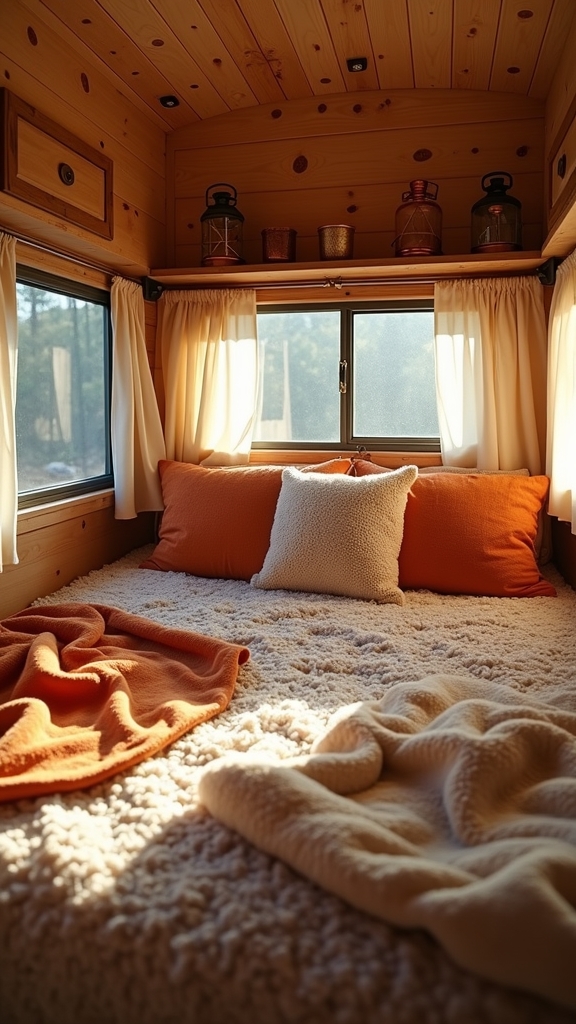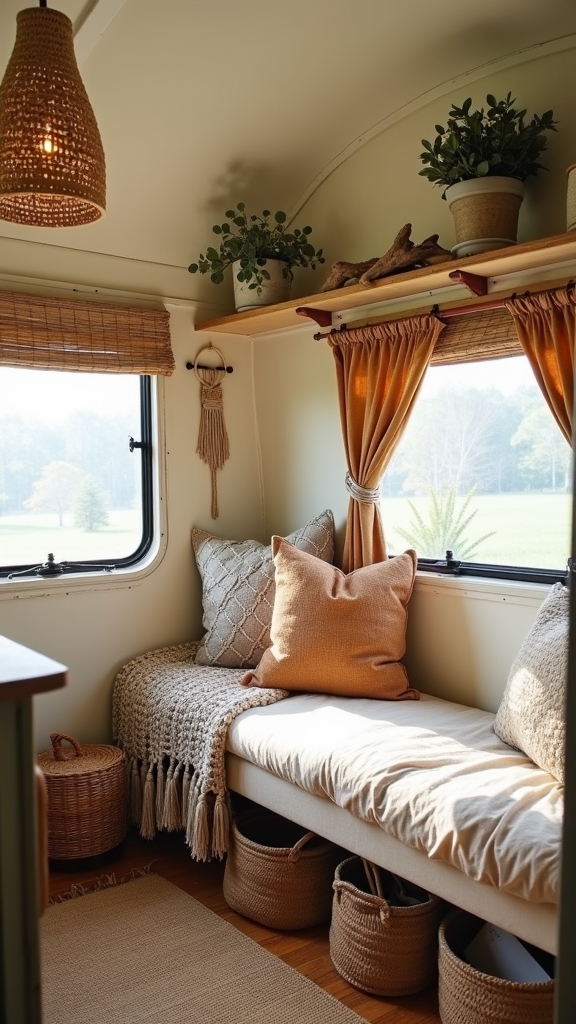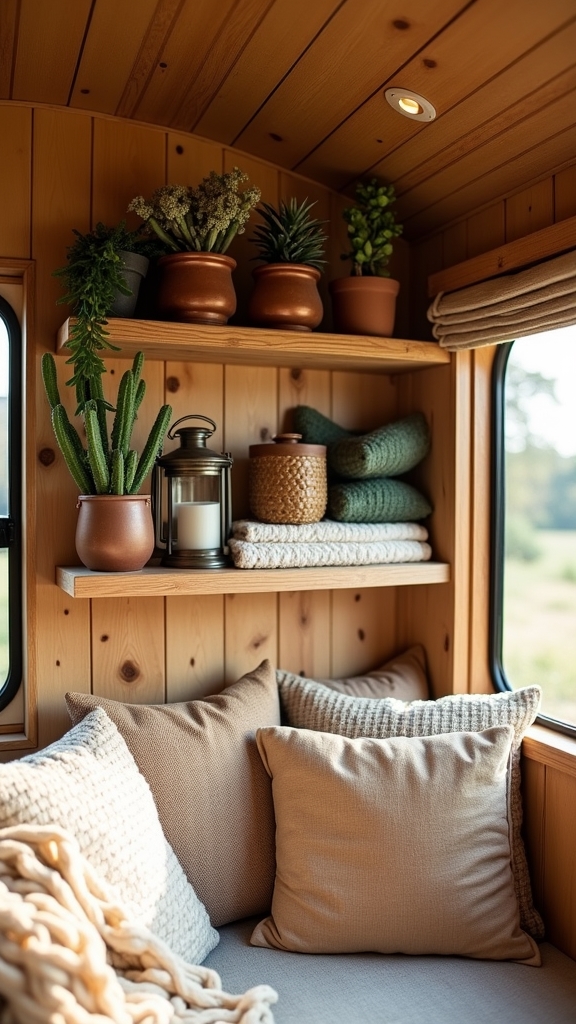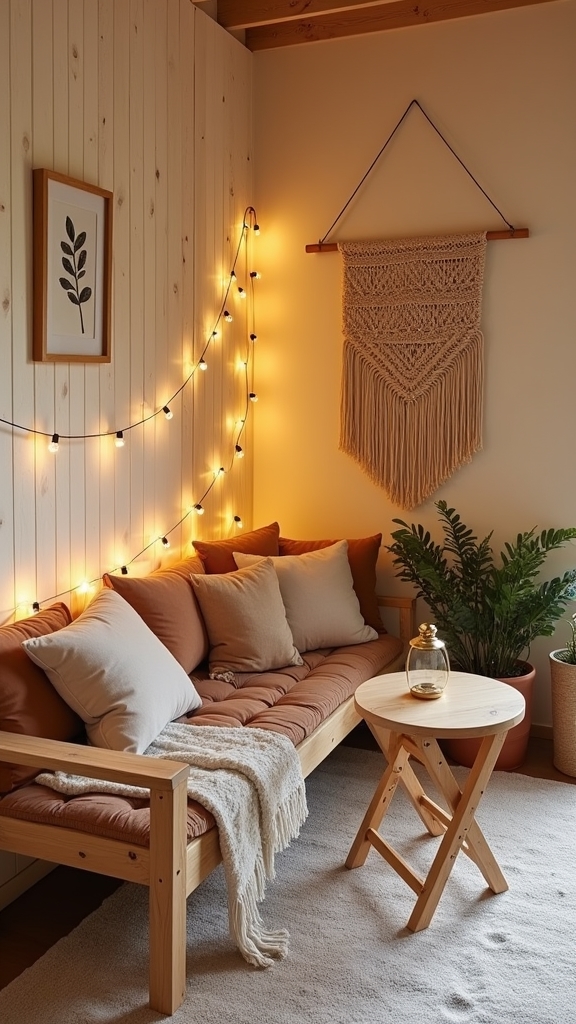You’ve dreamed of turning your camper into a cozy retreat, but those sterile walls and basic furnishings aren’t quite hitting the mark.
If you’re a weekend warrior or full-time nomad, transforming your mobile space into a warm, inviting sanctuary isn’t just about aesthetics – it’s about creating a true home on wheels.
By focusing on key design elements and smart modifications, you’ll discover how to infuse your camper with personality while maximizing comfort in even the smallest spaces.
Creating a Warm Color Palette for Your Camper

When transforming your camper into a cozy retreat, choosing the right color palette serves as the foundation for creating an inviting atmosphere.
Start with deep browns and rich reds paired with golden yellows to establish a warm, welcoming environment.
Natural wood accents complement these earth tones perfectly, creating that sought-after cabin-inspired ambiance.
For a personalized touch, layer in soft pastels or rustic elements, keeping in mind that your color choices should flow seamlessly between different areas of your camper.
RELATED: 10 Travel Trailer Office Setups Loved by Digital Nomads in Portland, Oregon!
Incorporating Natural Elements and Textures

To raise your camper’s interior beyond basic functionality, natural elements and varying textures serve as the cornerstone of a truly inviting space.
Start by incorporating raw wood elements through shelving and bamboo organizers, then layer in woven baskets for practical storage that doubles as decor.
RELATED: How to Personalize Your Travel Trailer With DIY Touches!
Setting the Perfect Ambiance With Lighting

The art of lighting can transform your camper from a basic living space into an enchanting retreat that rivals the warmth of any cozy cottage.
Start by installing dimmable LED strip lights under cabinets and along ceiling edges, giving you control over brightness and mood.
Set the scene with string patio lanterns that create a welcoming glow for your outdoor seating area.
RELATED: 12 Storage Must-Haves for Your Travel Trailer!
Choosing Cozy Fabrics and Textiles

Creating a cozy sanctuary in your camper begins with selecting the right fabrics and textiles, which serve as the foundation for comfort and style.
Choose durable materials like marine vinyl or synthetic leather for high-traffic seating areas, while incorporating softer cotton blends and linens where comfort is paramount.
For the best durability, look for materials with high Wyzenbeek ratings to ensure long-lasting performance.
For window treatments, opt for UV-resistant fabrics that provide both insulation and privacy. Remember to coordinate your color palette, limiting it to one or two primary hues for a sophisticated, cohesive look.
RELATED: 10 Decor Tips to Make Your Camper Feel Like Home!
Smart Storage Solutions That Feel Like Home

Smart storage transforms your camper from a basic living space into an organized haven that rivals the comfort of a traditional home.
Maximize every inch by installing modular units and wall-mounted organizers that utilize vertical space effectively.
Don’t overlook hidden gems like under-seat compartments and wheel well storage – they’re perfect for stashing essentials while maintaining a clutter-free environment.
In the kitchen, slide-out pantries and magnetic strips keep everything accessible while maintaining that cozy, home-like atmosphere you’re seeking.
Personalizing Your Space With Meaningful Decor

While setting up your camper’s essential systems and storage is crucial, personalizing your space with meaningful decor transforms it into a true home on wheels.
Create intimate vignettes by displaying cherished travel photos, souvenirs, and artwork that tell your story.
Layer in cozy textures with plush pillows and woven blankets, while incorporating natural elements like potted plants or wooden accents to bring the outdoors in.
Transforming Your Camper’s Layout for Comfort

To maximize comfort in your camper’s limited space, a thoughtfully planned layout serves as the foundation for an enjoyable mobile lifestyle.
Start by optimizing counter heights to 90 cm and ensuring walkways maintain at least 60-70 cm clearance.
Transform your living area with multi-functional furniture, like bench seats that convert to dining spaces, and install loft beds to create additional storage underneath.
Using cardboard mockups, experiment with different furniture arrangements to visualize your layout before making permanent installations.



